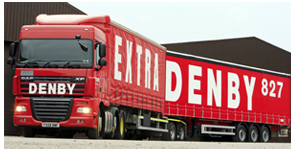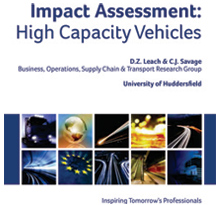Super lorries would benefit Britain
Thu, 01 Nov 2012 09:11:00 GMT
Expert's report on economic and environmental advantages of High Capacity Vehicles
 AWARD-winning research by a transport and logistics expert at the University of Huddersfield has shown that there would be economic and environmental benefits to individual companies and the country if the UK changed the rules to allow high capacity vehicles (HCVs) on to its roads.
AWARD-winning research by a transport and logistics expert at the University of Huddersfield has shown that there would be economic and environmental benefits to individual companies and the country if the UK changed the rules to allow high capacity vehicles (HCVs) on to its roads.
At 25.25 metres, they would be around a third as long again as the largest lorries currently permitted in Britain. But they would NOT carry heavier loads. They would be used for larger quantities of lightweight goods, therefore cutting down the number of vehicle journeys made, leading to significant cost savings, reduced carbon emissions and a lessening of congestion.
David Leach has now completed a detailed report into what is a highly-controversial topic. A paper based on his work was judged to be the best at the recent Annual Conference of the Logistics Research Network. Mr Leach’s focus is purely on extended vehicle length, while maintaining gross weight at the current UK standard, and this makes his research unique. Other studies have looked at increasing both weight and length simultaneously.
 The report is published by the University of Huddersfield (see electronic version at http://eprints.hud.ac.uk/15769/) and when it lands on the desks of politicians, lobbyists and specialist journalists it could help re-open a vexed debate.
The report is published by the University of Huddersfield (see electronic version at http://eprints.hud.ac.uk/15769/) and when it lands on the desks of politicians, lobbyists and specialist journalists it could help re-open a vexed debate.
“I think that in the right circumstances, for companies that transport lightweight goods in large quantities, from distribution site to distribution site, HCVs would be an undoubted benefit and would lead to a reduction in carbon emissions,” argues Mr Leach, who held senior positions in the logistics industry before switching to an academic career as a lecturer and researcher, specialising in freight transport and supply chain finance.
The rail-freight industry – fearing a wholesale switch to road transport – and safety campaigners – who are fearful of larger vehicles – have been rigidly opposed to larger vehicles in Britain. But David Leach’s findings run counter to many of their arguments.
He believes that only a small proportion of freight traffic is at risk of transfer from rail to HCVs, which are unsuited for heavy goods such as steel, coal and aggregates. European studies have shown that extra large vehicles do not create additional road safety problems and technical innovations mean that HCVs are equally as manoeuvrable as their smaller counterparts; and if their 50 per cent greater carrying capacity leads to fewer vehicles on the road, they could cut congestion.
Savings of £226 million
Currently, the maximum permitted length of freight vehicles on UK roads is 18.75 metres for a drawbar combination vehicle – a lorry plus trailer. But some European countries – notably the Netherlands – have exercised the right to opt out of the EU norm within their own boundaries and have permitted vehicles of up to 25.25 metres.
Crucially, although HCVs are longer and have a higher capacity, they would not be permitted to exceed the current maximum weight when loaded – 44 tonnes in the UK.
“You are increasing the cubic capacity of the vehicle but you are reducing the maximum weight of goods that it can carry,” explains Mr Leach. “This means that HCVs will only be of value to companies that distribute lightweight goods, such as snack foods, tissues and packaging materials.”
David Leach’s research was commissioned by Kimberly-Clark, the multi-national firm that manufactures a range of personal and health care products.
Mr Leach, who worked on the research with his colleague Chris Savage, estimated that about 15 per cent of the UK’s standard full-load traffic would be suitable for HCVs. This means that it is a niche market, but the numbers would still be significant.
Full adoption in the UK could lead to annual transport cost savings of £226 million, states the report. Total reductions in carbon emissions could amount to 96 thousand tonnes per annum and the use of HCVs would reduce the total distances travelled by large vehicles by up to 4 per cent, making a useful contribution to the relief of congestion.







